Family : Cercopithecidae

Text © Dr. Roberto De Simone member API

English translation by Mario Beltramini
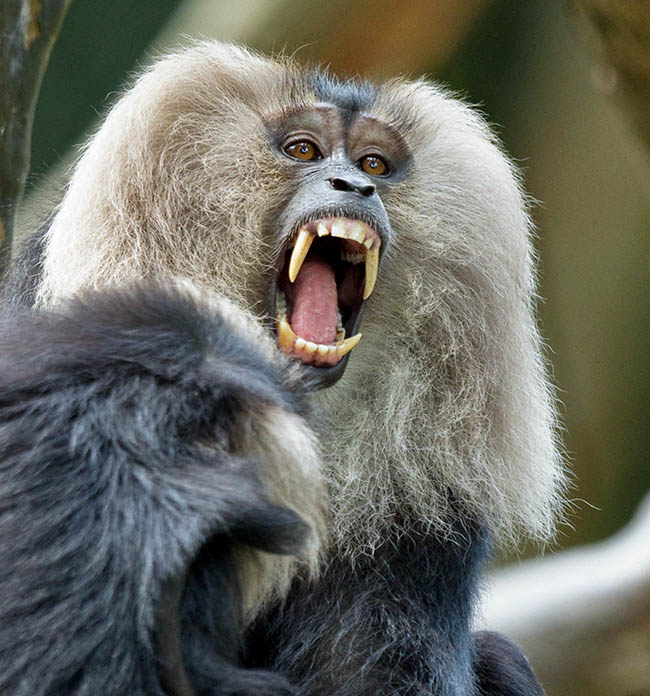
As the common name states, Macaca silenus evokes a lion: mane, tufted tail and showy canines in the males © Benny ng
The Silenus macaque (Macaca silenus Linnaeus, 1758), commonly known as Lion-tailed macaque, or White bearded monkey or Beard ape, belongs to the family Cercopithecidae.
The genus Macaca comes from the Portuguese “macaco”, adaptation of an African natives’ epithet.
The specific name silenus is that, Latinized, of mythological beings of old Greece, the “Sileni”, represented under human forms, ears, tail, and, sometimes, even with horse legs.
Within the genus Macaca, this species is often placed by the scholars in the evolutionary branch “silenus-sylvanus”, where stand also Macaca nemestrina, Macaca sylvanus and the Sulawesi species.
Zoogeography
Macaca silenus is presently endemic to the rainforest of Western Ghats of South-East India.
Ecology-Habitat
M. silenus is one of the species of macaques most linked to the evergreen tropical pluvial forest and stands also among those having more strictly arboreal habits, as it spends on the ground only the 1% to the 10% of its time.
Though adapting to a very varied diet, like other species of macaques, the feeding of this monkey is, in fact, rather selective.
In the tropical rainforest the food resources may be temporally limited by the climatic variability and distributed in a very vast area.
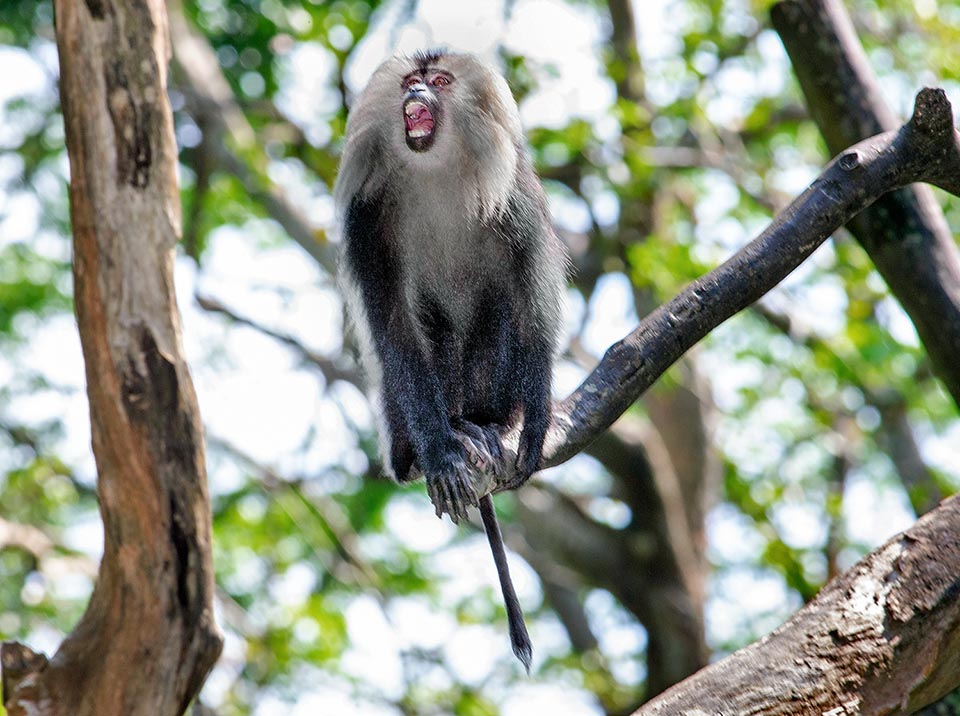
Endangered species, with maybe only 2500 adults in nature, endemic to the rainforest of Western Ghats in South-East India © Giuseppe Mazza
Its main food consists of the fruits of the trees belonging to the genus Ficus.
When these fruits are less abundant, it can complete its diet with a variety of foods that include seeds, sap, flowers, buds, leaves, snails, insects; eggs of birds, tree frogs and other animals like lizards, bats, and puppies of the Indian giant squirrel (Ratufa indica).
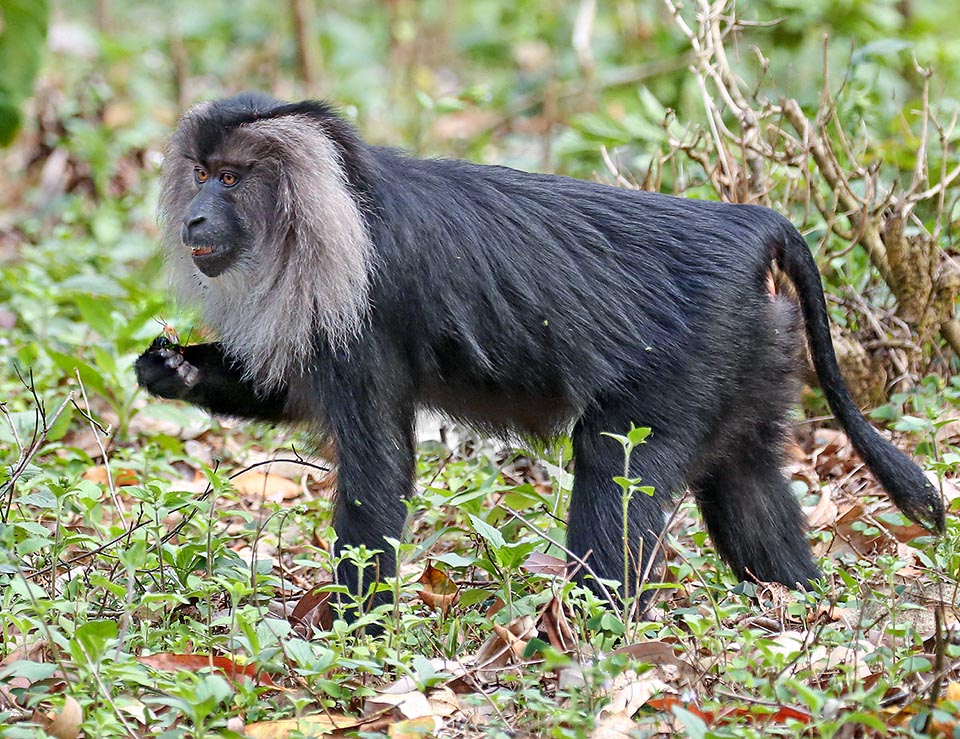
Rarely goes down to the soil for food, when on the trees the Ficus fruits are scarce, as they stand at the base of its diet, here integrated by an insect © Roger Wasley
The habitat occupied by the Lion-tailed macaque is rapidly changing due to the intrusiveness of human activities, with fires and diffusion of intensive crops. The tall trees are cut or burnt in order to create room for the cultivation of non-endemic plants.
The decreasing population has been obliged to adapt, starting, for instance, to feed with non-endemic plants, like that of the coffee.
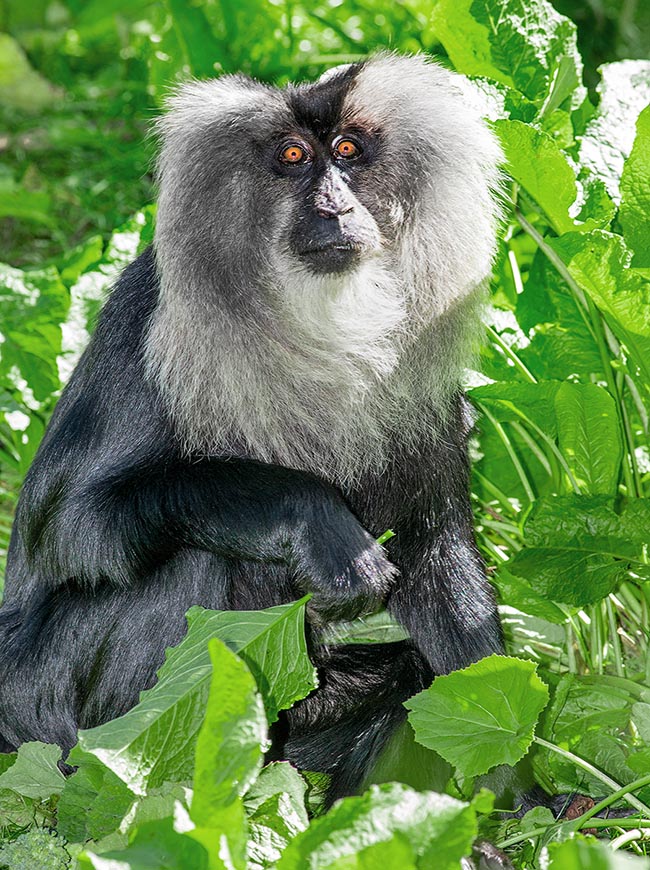
Does not ignore leaves, flowers, buds, snail, bird eggs, tree frogs and other small vertebrates it finds in the branches © Giuseppe Mazza
The grazing in the cultivated areas as well as the consequent competition with the local farmers, form a further threat to their survival.
Besides the seasonality, that, especially between September and November, makes less available the fruits it nourishes of; it’s especially the deforestation that obliges them to spend more time feeding on the ground, exposing them on this way to bigger dangers of predation, also by the human beings.
The Lion-tailed macaque carried on an important role in the dispersion of the seeds.
Carrying the fruits in the cheek sacs, and carrying the same for a long way, in fact, drops the seeds or deposits them with the feces, far away from the plant that has generated them.
In this way it contributes to the survival and the propagation of many vegetable species in their own environment.
Morphophysiology
The Lion-tailed macaque stands among the smallest species of macaques, with a height of about 40-60 cm and an average weight of 8,9 kg for the males and of 6,1 kg for the females. The tail, which may be 24 to 38 cm long, helps in keeping the balance when moving on the trees.
The showy and majestic silvery white mane, that appears on both sexes when about two and a half years old, in evident contrast with the black mantle of the body and the glabrous black face, evokes, with the pointed tuft at the tip of the tail, the appearance of a lion, hence the vulgar mentioned name and the epithet “Singalika”, used in India, that means “like a lion”.
The snout is long, with big nostrils. The males have long and sharp canines they display to hold away the other males. The newborns come to life with faces paler than those of the adults.
Like the other species of macaque, also the Lion-tailed macaque has cheek sacs able to contain a remarkable quantity of food, characteristic useful for storing a food surplus while eating.
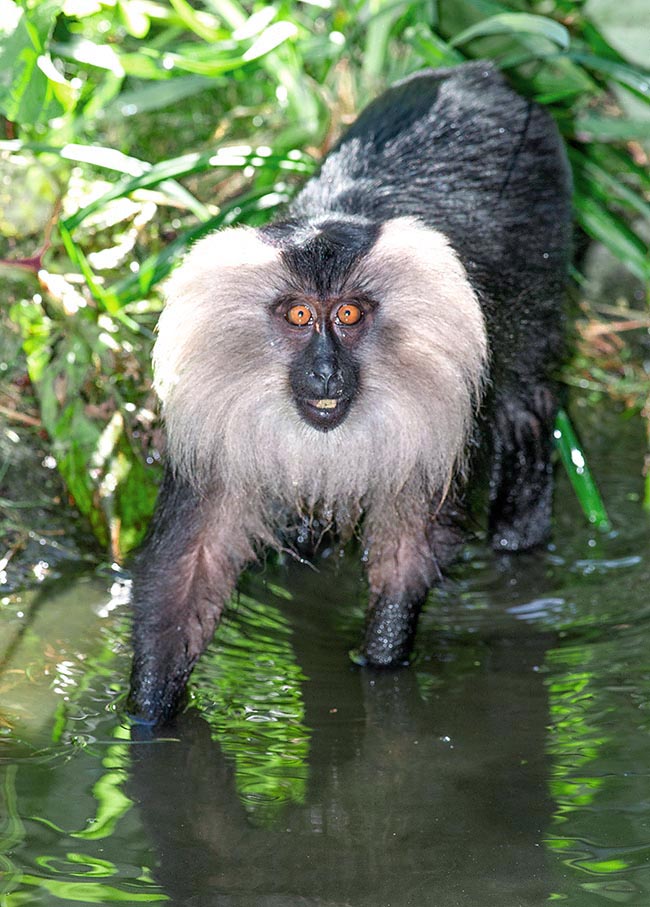
This, after drinking, looks for something in a water stream: a root to chew or maybe a fallen fruit © Giuseppe Mazza
Ethology-Reproductive Biology
The Lion-tailed macaque is a diurnal animal and usually lives in groups of 10-20 individuals.
After some demographic studies, the presence of one single adult male in the group should be the most typical situation, but latest searches suggest that this composition is mainly found in impoverished habitats.
A population study, done following 8 groups for some years, has reported an average dimension of the group of 20-21 individuals, 1-2 of which are adult males (> than 6 years), 1-2 sub adult males, 8 adult females and 9-10 immature individuals.
However, even when there are present more adult males in the same group (there can be up to three of them), only one is the dominant one.
Among the groups surveyed, the ratio of adult males and adult females was, averagely, of 1 to 5,7.
The dominant males do protect the other members of the group against the nearby groups.
The females remain with the origin group and acquire a higher hierarchically social status as they get older.
Common manifestation of high social status is represented by the greater frequency of “grooming” (the typical activity of cleaning of the hair, that, in the non-human primates, gets an important social value), from which these females do benefit.
Conversely, the males tend to abandon the group where they were born once they reached their sexual maturity, at an average age of 4,7 years.
Looking for a new group where to settle, they usually join other emigrant males forming groups more or less stable over time.
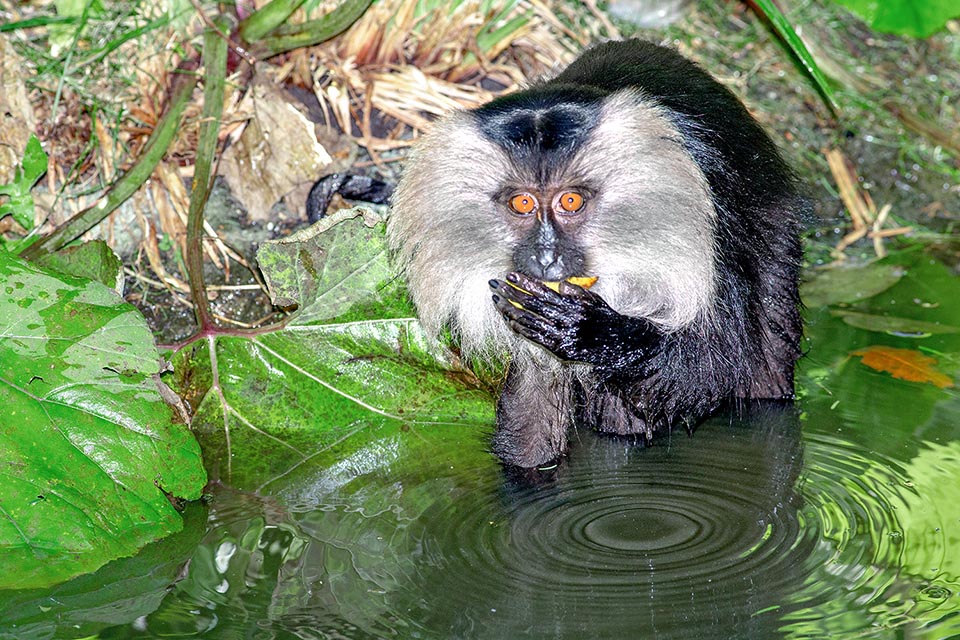
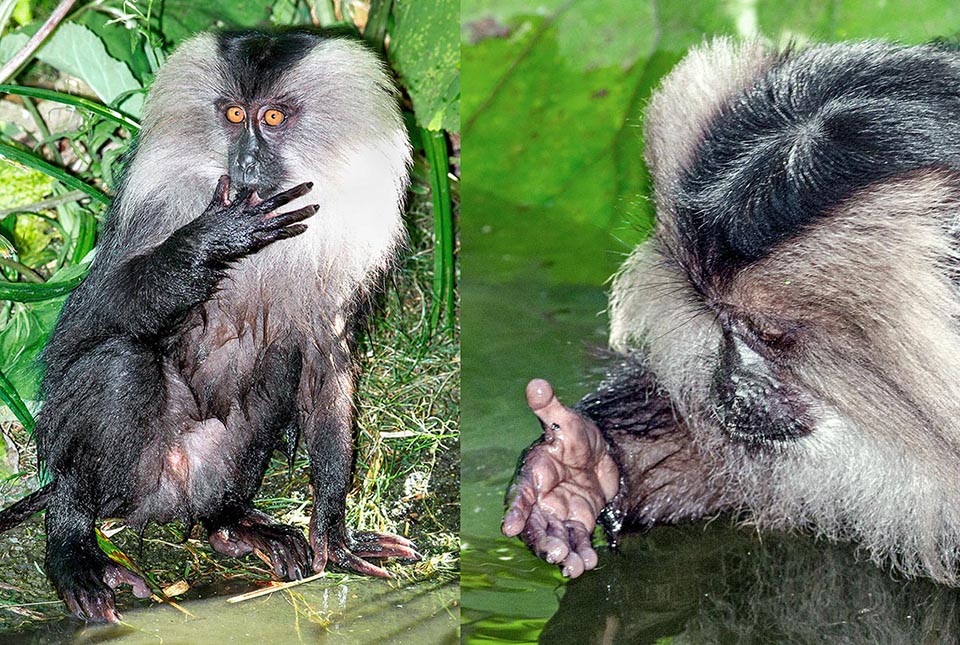
Decidedly tasty, to leak fingers. Now looks at its hand now empty, looking almost human, and will resume looking. The Lion-tailed macaque is a day animal, with a height of about 40-60 cm, living mainly in groups of 10-20 individuals. They spend almost half of the day in feeding and the other half in resting or in moving looking for food © Giuseppe Mazza
During this phase of their life, for the young males the competition is high. Often, they migrate several times in several different groups, where, occasionally, they can compete with the dominant male, take its place and permanently settle.
Most births coincide with the peak of the rainy season, when the food resources get more abundant.
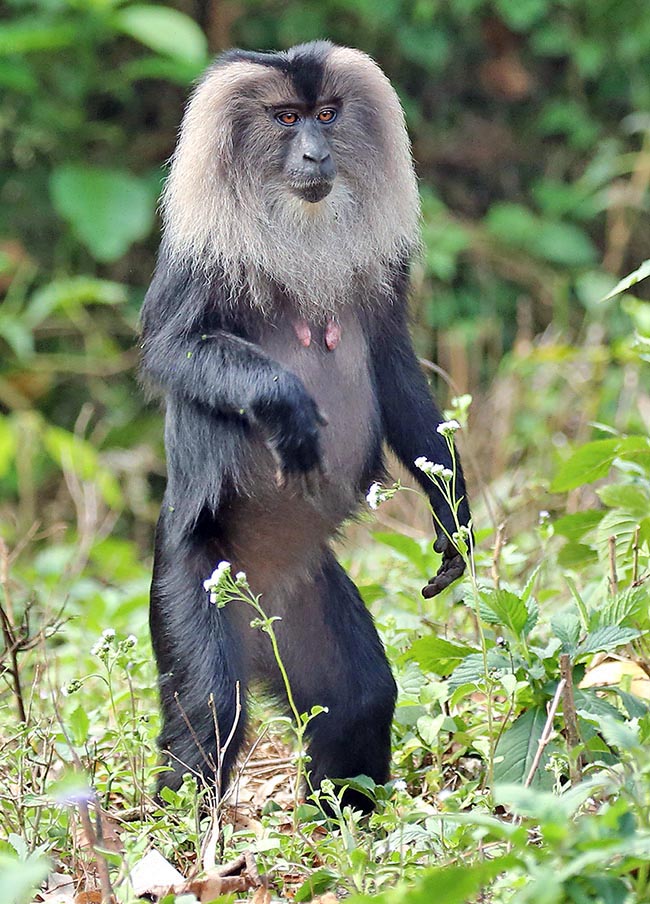
Female in erect posture. It’s still breastfeeding, and is equally on the ground looking for food © Roger Wasley
When in estrus, besides manifesting a swelling under the tail, the female emits a courting call to inform the males that she is ready for coupling.
Even if there are several males in the group, only the dominant one can have access to the pairing, not before having inspected and smelled its genitals.
The females have their first delivery when about 6 years old.
Usually, they give birth to one young only, after a gestation period of 170 days.
Then they load it on their chest or on their back until weaning, that occurs when about 15 months old.
At least two and a half years will pass between one delivery and the subsequent one.
The Lion-tailed macaque spends about half of its day in feeding and the remaining half in resting or in moving while looking for food.
It devotes little time to social activities such as hair cleaning (grooming) or playing. In particular, the males interact with the other members of the group less frequently than the males of other species of macaques.
In the wild, have been observed behaviors of use of tools, such as the leaves used for taking off the poisonous stings of the chrysalises before eating them or as sponges to extract the water from the holes of the trees.
In captivity, a group of Lion-tailed macaques has been able to create tools useful for extracting the syrup from a container left at their disposal.
The dominant males emit vocal calls at the territorial boundaries to keep at bay and define the distance with the nearby groups. Conversely, vocalizations with bared teeth are demonstrations of strength, usually sufficient to prevent fights. If a challenger does not back away, however, the fight between males can cause serious injuries, usually lacerations inflicted with their long canines. Like for other species of macaques, the studding behavior can be used as manifestation of strength and of dominance on a subordinate individual.
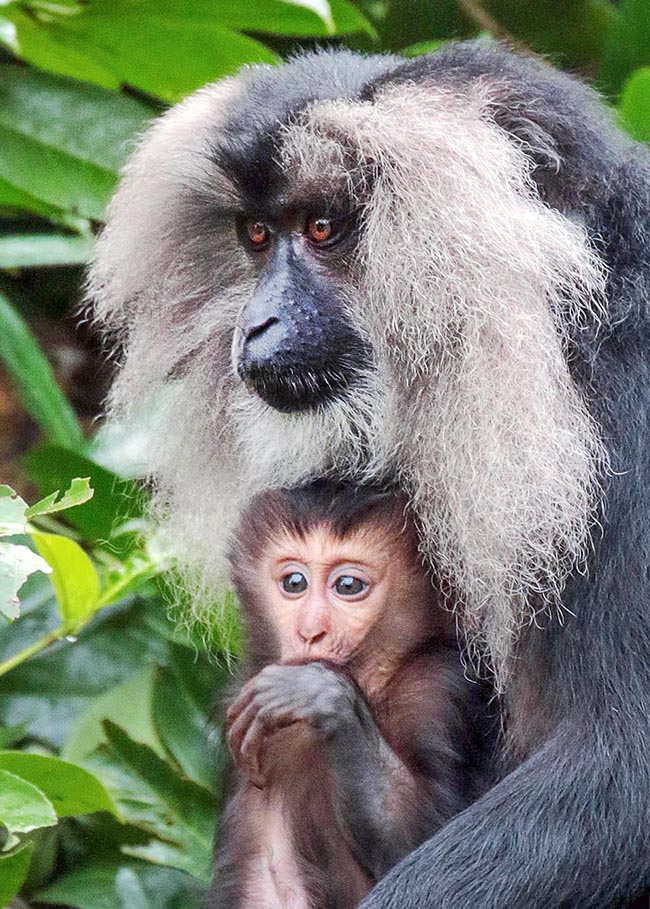
Babies come to life with a face decidedly paler than adults. This one, having no dummy, sucks its thumb © Safi Kok
Shaking energetically a branch is another aggressive or demonstrative behavior, apt to exhibit strength or discontent toward one or more conspecifics.
Aggressive manifestations and warning calls are used also against other species like the Indian giant squirrels when they enter into competition for the same food resources.
The “lips making” is the typical friendly signal of the macaques, used also for displaying subordination to the members of the group having a higher social status.
Conservation
The Lion-tailed macaque may live up to 20 years when in the wild and almost 40 when captive.
It is classified by the International Union for Conservation of Nature (IUCN) as an endangered species and is inserted into the Red List.
There might be less than 2500 adult specimens in the wild and it is expected that the species will reduce further by more than 20% in the next 25 years.
The natural predators, that include the Crested serpent eagle (Spilornis cheela), the Mountain hawk-eagle (Nisaetus nipalensis) and the Dhale (Cuon alpinus), do not represent dangers for the survival of the Lion-tailed macaque, as serious as is the fragmentation of its habitat.
From 1860 the forest of Western Ghats has been exploited for the tea and coffee plantations and for the timber harvesting, thus leading to the creation of areas of shrubby forest that render more difficult the survival of this species.
In some zones, like the Valparai highland or the Anaimalai hills, some groups of these macaques cannot find food and use the dumps for their sustenance.
In the last years, many individuals have been killed, hit by the cars, most numerous and fastest, that circulate after the extension of the motorway for Valparai, needed to facilitate the traffic of residents and tourists.
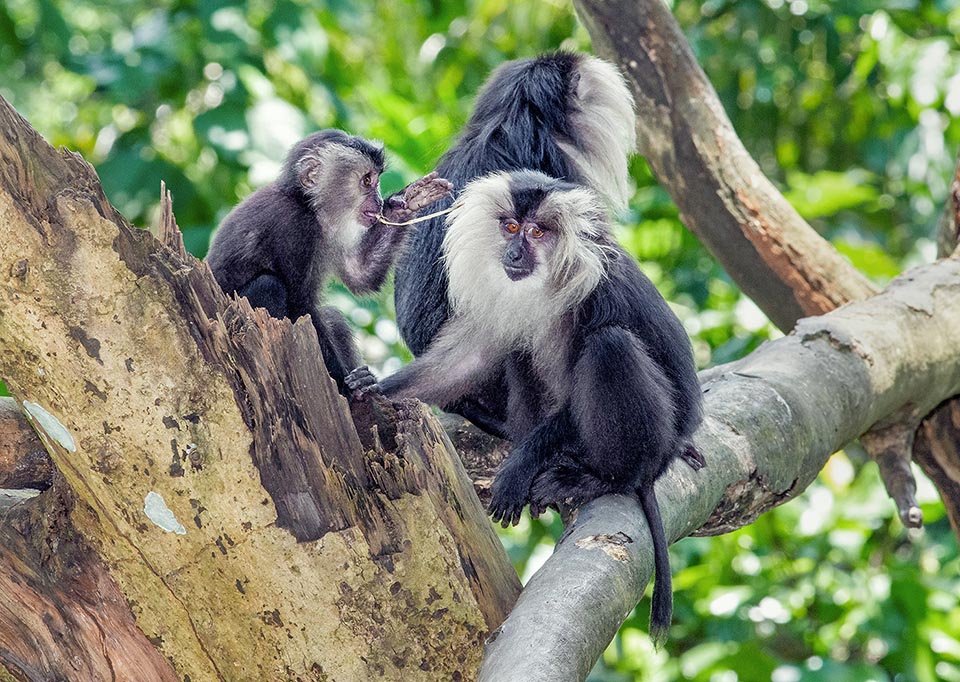
Little family between branches. Females usually deliver only one baby, and between one delivery and the next pass at least two and a half years © Giuseppe Mazza
The empty spaces created by the deforestation oblige these primates to go down to the soil for crossing the shrubs of forest. Some are killed by man whilst others meet their death in accidents, not only road ones, while trying, for instance, to use the electric lines as elevated paths for their movements.
With its own territory reducing more and more, the Lion-tailed macaque, for eating, is now obliged to leave the security provided by the forest.
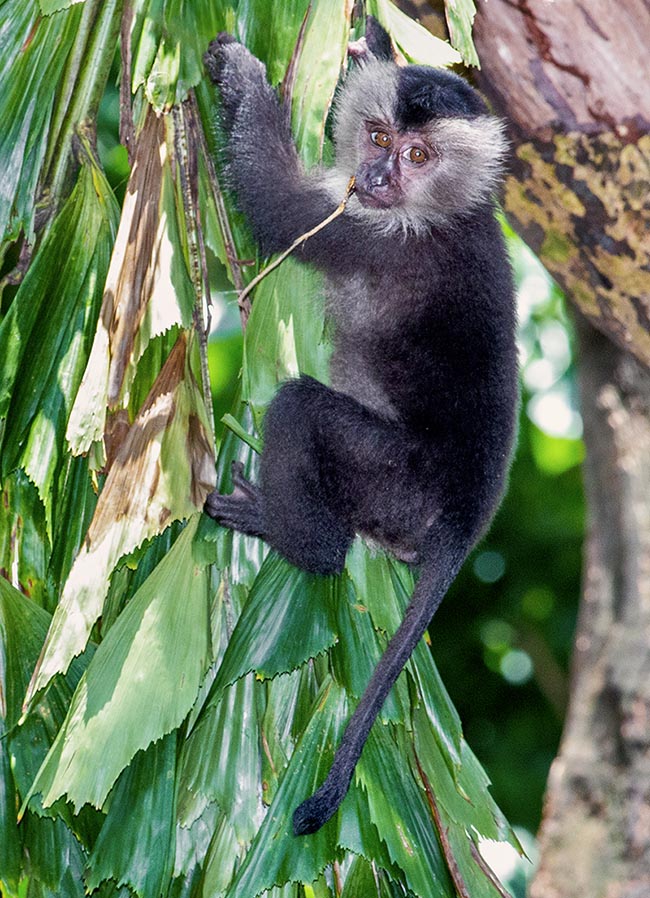
This one, already assuming the adults’ hair, is always moving © Giuseppe Mazza
This increases the situations of conflict with the human beings for instance in areas where the macaques have learnt by themselves to remove the tiles to enter the houses where to steal the food.
Other threats include the poaching for wild meat and the trade of exotic animals.
In addition to all this, when the wildlife and the human settlements stand very close, there is always a danger of spreading diseases from one species to another. In the case of the Lion-tailed macaque, a high quantity of gastrointestinal parasites has been noted in groups living close to human settlings and to cattle farms. Furthermore, it is thought that the presence of the parasites is a factor that significantly affects the reduction in the birth rate and in the survival of these groups.
The Lion-tailed macaque is included in the Appendix I of the Convention on International Trade in Endangered Species of Wild Fauna and Flora (CITES) and is also protected in accordance with the Annex I, part I, of the Indian Wildlife (Protection) Act of 1972. Several protected areas and national parks have been recognized by India as important areas to be preserved.
However, the management of the forest areas is made difficult by the fact that many of them are located in private lands, where the forest department has no jurisdiction. During the last 20 years, the population of these primates has constantly decreased and in some parts of the Western Ghats the species seems to have totally disappeared.
Some patches of forest have been separated already for many decades and the genetic isolation between the groups forms a real and serious danger. Hence the urgent need arises to create forest corridors that can allow the connection between these groups, favoring genetic differentiation and ensuring these animals the possibility of reproducing and of thriving. This aim can be reached through the reafforestation, planting endemic arboreal species. This not only will reconstitute the disappeared forest areas but will furnish new food resources to these primates.
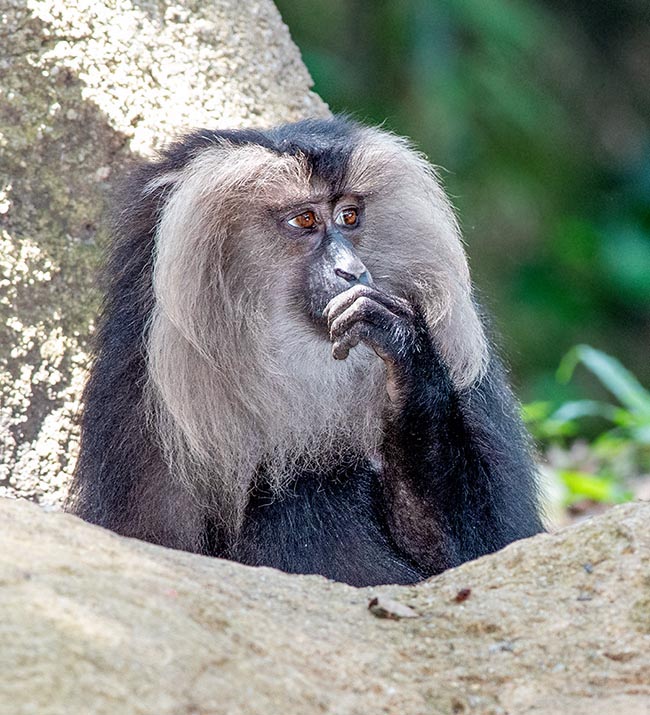
Mother observes it pensive. The Lion-tailed macaque can live up to 20 years in nature and almost 40 when captive © Giuseppe Mazza
The conservation agencies must work closely together with the local forest department, with the private owners of the lands, the municipalities, and the local residents.
Moreover, public education must be able to contribute in modifying the negative image the persons may have of these animals.
Teaching not to feed wild animals, to prevent the waste disposal in open areas, to guarantee their regular collection (including that of the medical wastes) and to adopt precautions for protecting the houses from the “raids” of the macaques, all these are actions that can be undertaken to prevent and reduce the conflicts between monkeys and human beings.
Finally, the conservation efforts also include the breeding in captivity.
The first Lion-tailed macaques were introduced in the American zoos during the XIX century.
When they began to pay attention to the decrease of the wild populations, they implemented a program of breeding and the species was inserted in the Species Survival Plan (SSP), what is presently known as Association of Zoos and Aquariums (AZA).
The purpose was that of establishing a viable population in captivity.
Europe joined this effort in 1989, and Italy in 1996. Unfortunately, so far, in India the breeding in captivity has not given the desired results.
Synonyms
Cercopithecus vetulus Erxleben, 1777; Simia ferox Shaw, 1792; Simia silenus albibarbatus Kerr, 1792.
→ For general notions about Primates please click here.
→ To appreciate the biodiversity within the PRIMATES please click here.
